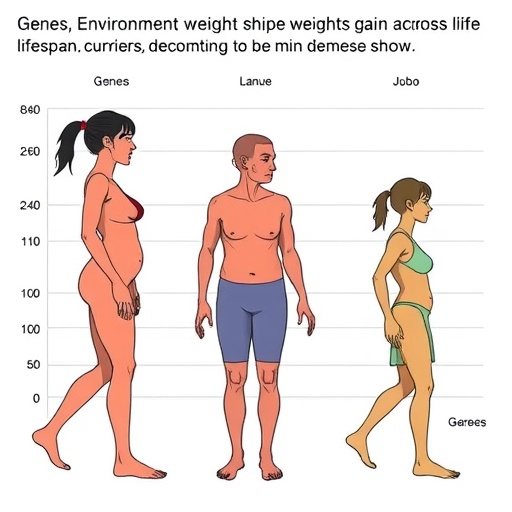In the exhilarating realm of mountain biking, the thrill of speeding down rugged trails offers an unmatched sense of freedom and adventure. However, with this thrilling pastime comes inherent risks, particularly concerning head injuries during falls. Recent research led by a team of scientists, including Ma, Gosal, and Kim, delves into the biomechanical risk factors associated with head impacts during mountain biking accidents, exposing the intricate interactions between rider behavior and environmental elements that contribute to the severity of injuries sustained in such events.
The study reveals that mountain biking is not merely a test of skill and stamina but also a domain fraught with biomechanical challenges. When riders encounter abrupt changes in terrain, their bodies must respond swiftly to maintain balance and control. Unfortunately, in the event of a fall, the forces exerted on the head can be catastrophic. Understanding these forces can potentially lead to enhanced protective gear and riding techniques that might mitigate the risk of head injuries.
One significant aspect of the research is the analysis of rider posture and its impact on injury risk. It was observed that riders who maintain a low center of gravity are better equipped to handle sudden shifts in balance. Conversely, those with an upright posture might struggle to react swiftly enough, leading to dangerous falls. This highlights the importance of proper riding techniques and the role of training in reducing head impact risks. By encouraging riders to adopt safer postures, we might be able to significantly decrease the rate of head injuries.
The research further dissects the influence of environmental conditions on fall severity. Variable factors such as surface material, incline angle, and obstacles along the trail can profoundly affect how a fall unfolds. The findings suggest that riders navigating rocky terrains or steep descents are at greater risk not only of falling but also of sustaining severe head injuries upon impact. Understanding these environmental factors provides a valuable framework for developing safer trails and safer designs in equipment aimed at mountain bikers.
Moreover, the study takes a closer look at the relationship between speed and the mechanics of head impacts. The researchers found a direct correlation between the velocity of the bike at the moment of a fall and the force of the subsequent impact. As the speed increases, so does the risk of sustaining a more severe head injury. This correlation emphasizes the necessity for bikers to gauge their speed relative to their skills and the environment, reinforcing the importance of situational awareness while riding.
Particularly intriguing are the biomechanical analyses of helmets commonly used in mountain biking. While helmets are a critical component of rider safety, the research suggests that not all designs offer the same level of protection against head impacts. The study hints at the potential for innovative helmet designs that better absorb shock and disperse impact forces over a broader surface area, thereby providing enhanced protection. Such advancements in helmet technology could revolutionize how mountain bikers protect themselves and significantly reduce the incidence of severe head injuries.
Furthermore, the team examined the impact of rider experience on injury rates. It appears that inexperienced riders are more likely to sustain head injuries compared to their seasoned counterparts. This discrepancy highlights the critical role of education and experience in mountain biking safety. Implementing training programs to teach safety and control techniques could significantly reduce injury rates among novice riders.
The research team also emphasizes the psychological aspects of riding, including fear and risk perception. Experienced bikers often develop a keen intuition about terrains that can lead to potential falls. However, less experienced riders may underestimate the risks they’re facing, leading to poor decision-making in hazardous situations. By fostering a culture of risk awareness and respect for the sport, the mountain biking community can promote safer practices that reduce the likelihood of falls and head injuries.
Notably, the study addresses the multi-faceted nature of head injury risk, indicating that a combination of factors—including rider behavior, environmental conditions, and equipment—must be considered when tackling the issue of head impacts. This holistic approach extends beyond individual practices and into the overarching culture of mountain biking, advocating for improved safety standards and awareness at all levels.
Additionally, the research prompts a discussion on the role of technology in enhancing rider safety. The integration of smart technologies into mountain bikes, such as collision detection systems or real-time feedback mechanisms, could provide riders with crucial information to avoid hazards and fall scenarios. Developing such technologies may play a pivotal role in reducing head injuries, shifting the current landscape of mountain biking safety towards a more data-driven and technologically advanced future.
In conclusion, as mountain biking continues to grow in popularity, so does the need for a comprehensive understanding of the biomechanical risks riders face during falls. The insights from Ma, Gosal, and Kim’s research underline the complex interplay of rider dynamics, environmental factors, and equipment design in preventing head impacts. It is imperative that the mountain biking community, including riders, manufacturers, and recreational facilities, actively engage in discussions around safety innovations that can lead to a more secure riding environment. By prioritizing injury prevention and adopting more informed practices, the thrill of mountain biking can be enjoyed with a significantly reduced risk of head injuries, allowing enthusiasts to fully embrace the joy of the ride.
Subject of Research: Biomechanical risk factors for head impacts during falls in mountain biking.
Article Title: Biomechanical Risk Factors for Head Impact during Falls in Mountain Biking.
Article References:
Ma, R., Gosal, S., Kim, F. et al. Biomechanical Risk Factors for Head Impact during Falls in Mountain Biking. Ann Biomed Eng (2025). https://doi.org/10.1007/s10439-025-03904-x
Image Credits: AI Generated
DOI: https://doi.org/10.1007/s10439-025-03904-x
Keywords: Mountain biking, head injuries, biomechanical risk factors, rider safety, equipment, helmet design, environmental conditions, rider experience.
Tags: biomechanical head impact risksbiomechanics of cycling accidentsenvironmental factors in cycling accidentshead injuries in cyclinglow center of gravity in bikingmitigating head injury risksmountain biking research studiesmountain biking safetyprotective gear for mountain bikersrider behavior and injury preventionrider posture and injury riskterrain changes and falls





